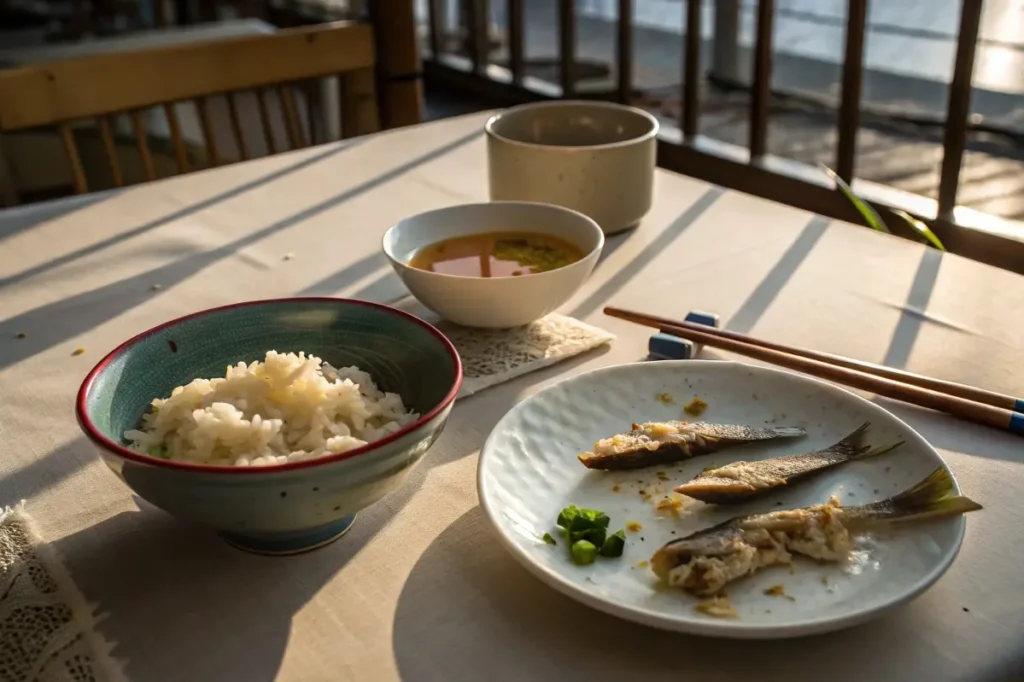Introduction
A common Japanese breakfast foods lineup might appear simple at first glance—steamed rice, miso soup, perhaps a portion of grilled fish—but beneath its modest façade lies a deep-rooted culinary philosophy that emphasizes balance, variety, and seasonality. Whether you’re traveling through Tokyo at dawn, preparing a quick morning meal in your own kitchen, or searching for new ways to diversify your breakfast routine, Japanese morning staples offer unique textures and flavors that set them apart from Western offerings.
From comforting soups and marinated proteins to pickled vegetables and a range of condiments, these early-morning dishes deliver a burst of umami and the satisfying feeling of a well-rounded meal. In this article, we’ll take a close look at common Japanese breakfast foods, explore how they’re served, and discuss the cultural significance of each. We’ll also delve into the typical mealtime habits, the “samurai” approach to morning nourishment, and how families manage breakfast before school or work. For those who wish to recreate these dishes at home, we’ll offer references—like traditional-japanese-breakfast—so you can see real examples that illustrate the timeless appeal of Japan’s morning fare.
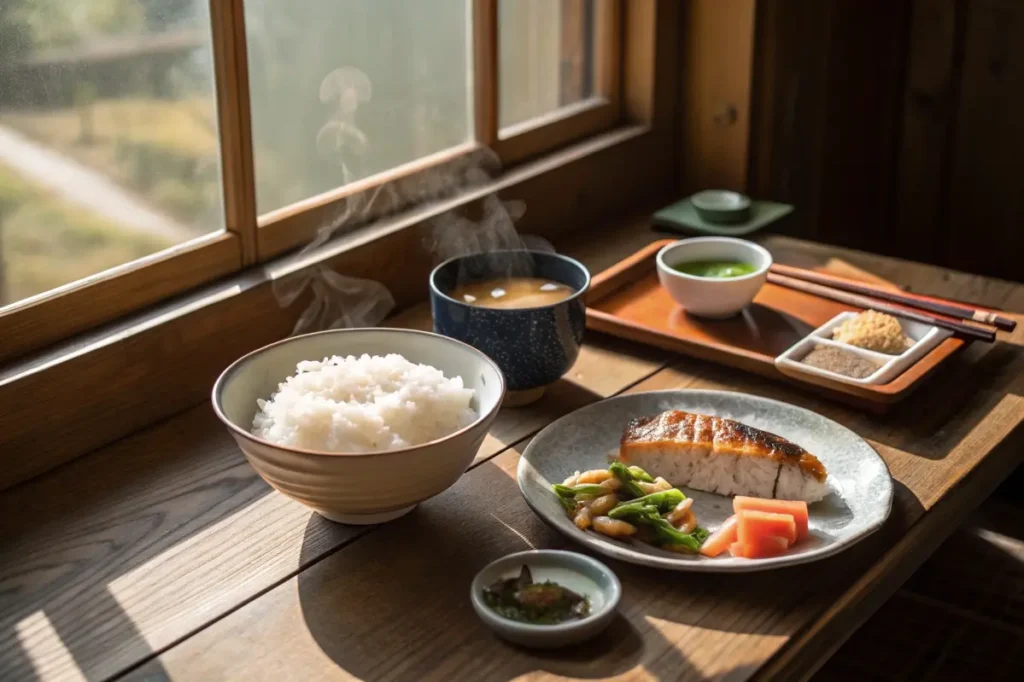
1. Key Elements of a Common Japanese Breakfast
1. Steamed Rice (Gohan)
Steamed short-grain rice is the linchpin of most Japanese meals, and breakfast is no exception. Its naturally sticky, slightly sweet grains pair well with savory sides. Some families opt for genmai (brown rice) or a blend of grains for extra fiber.
2. Miso Soup (Misoshiru)
A bowl of hot miso soup offers warmth and nourishment, thanks to fermented soybean paste dissolved in dashi (broth). Common add-ins include tofu, wakame seaweed, and seasonal vegetables like radish or carrots. If you’re pressed for time, instant miso soup packets can approximate the taste with minimal prep.
3. Grilled Fish (Yakizakana)
Salmon or mackerel are go-to choices for a rich protein source. Typically seasoned with salt, they’re either broiled or grilled. The smoky aroma complements the mild sweetness of rice. Leftover fish—if any remains—sometimes reappears at lunch, reducing waste in a culture that highly values resourcefulness.
4. Pickled Vegetables (Tsukemono)
Tangy pickles such as takuan (pickled daikon) or umeboshi (pickled plum) brighten the meal, countering the rich, savory elements. They also cleanse the palate between bites, adding a crisp mouthfeel. For more vegetable-centric recipes, vegetables-japanese-recipe can guide you on quick prep methods.
5. Eggs in Various Forms
A rolled omelet called tamagoyaki provides a sweet-savory contrast; some families prefer soft-boiled eggs or scrambled eggs with soy sauce. The speed and versatility of eggs appeal to modern lifestyles while staying true to local flavor profiles.
6. Condiments and Extras
- Nori (Dried Seaweed): You might see it used to wrap small portions of rice or sprinkled as a garnish.
- Furikake: Flavored seasoning—sesame seeds, dried fish flakes, seaweed—to jazz up plain rice.
- Soy Sauce: A dash can amplify flavors, whether on eggs or fish.
Portion Control and Balance
A common Japanese breakfast typically includes multiple small dishes, ensuring a balance of macros: protein, carbs, and micronutrients from vegetables. This approach, reflecting Japan’s culinary ethos, not only helps manage portion sizes but also fosters appreciation for each dish’s distinct taste. If you want a more elaborate spread, leftover japanese-chicken-fried-rice-recipe can fill in for steamed rice, offering a quick but hearty start to the day.
Practical Tips
- Prep in advance: Cook extra rice the night before and store it in the fridge.
- Quick fish: Marinate fillets in soy sauce or salt overnight for faster grilling.
- Instant shortcuts: Keep miso soup packets or pre-pickled vegetables handy.
By incorporating these staple items, you’ll experience the comforting synergy that makes a common Japanese breakfast foods lineup so satisfying. Over time, you might experiment with seasonings or new pickles, forging a personalized routine that resonates with Japan’s time-honored traditions.
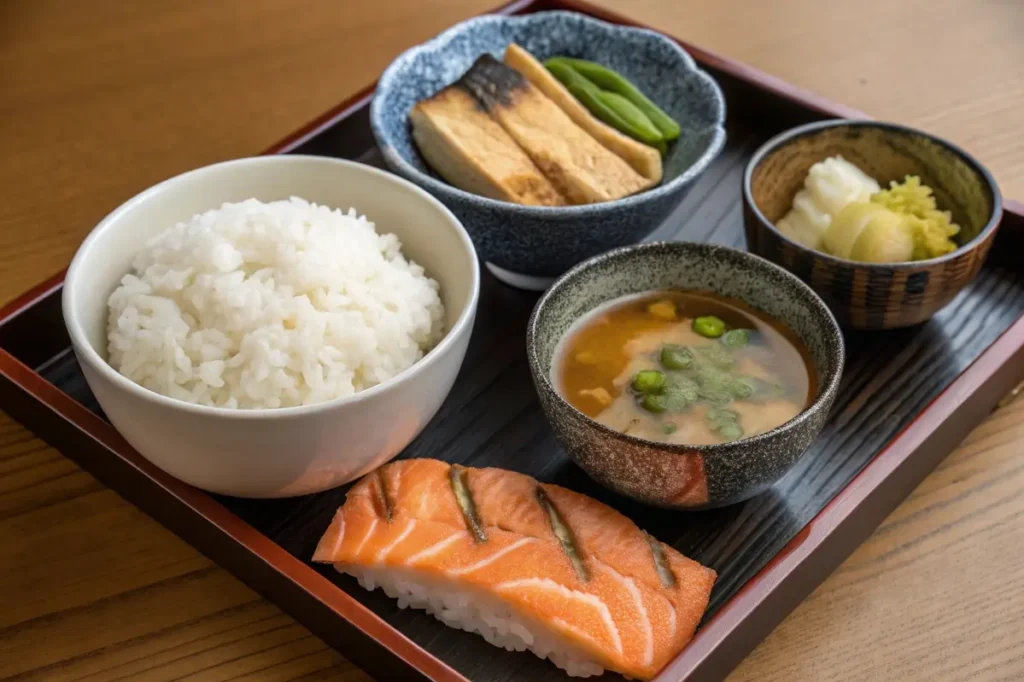
2. Understanding the Typical Flow of a Japanese Morning
What time do Japanese eat breakfast? Typically between 6:30 and 8:00 AM on weekdays. Schoolchildren and office workers rise early, often with minimal time to spare before heading out. Weekends or holidays, however, can shift breakfast to a leisurely 9:00 or 10:00 AM, allowing families to indulge in a more elaborate spread.
Morning Schedules and Quick Meals
Many Japanese households rely on speed and efficiency on weekday mornings. Konbini (convenience stores) are ubiquitous, offering ready-made onigiri (rice balls), bottled tea, and sandwiches. For those who prefer a home-cooked vibe, leftover dinner items or instant soup help maintain a balanced meal. If you’re juggling limited minutes in the morning, a small portion of japanese-curry-recipe-one-piece over leftover rice can stand in for a traditional set.
What does a samurai eat for breakfast? Historically, samurai diets weren’t too different from farmers or artisans, featuring rice, fish, pickled vegetables, and occasionally miso soup or tofu. The difference lay in portion sizes or the quality of ingredients, not an entirely separate cuisine. In modern times, the phrase “samurai breakfast” might imply a robust morning meal focusing on hearty proteins like fish or eggs, ensuring stamina for the day’s challenges.
Kids and School
With many students leaving home by 7:00 AM, breakfast sometimes gets compressed to a quick meal. Parents might offer a smaller version of the adult set—steamed rice, pickles, a bit of egg or fish—ensuring enough nutrients to stay alert through the morning’s classes. If time is tighter, toast and jam or an onigiri become substitutes. Some schools offer breakfast programs, but that’s less common than in certain Western nations.
Weekday vs. Weekend Contrasts
- Weekdays: Speed is key. Leftover minced-beef-japanese-recipe or a packet of instant miso soup may accompany rice.
- Weekends: Families often relish cooking fish fresh, making miso soup from scratch, or trying new side dishes like natto. They may also serve sweet items—fruit, or pastries influenced by Western brunch culture.
Balancing Tradition and Modernity
Though Western influences—coffee, cereal, toast—have found their place, many Japanese households stay anchored to time-tested staples, validating the concept that old and new can coexist on a single table. A parent might enjoy grilled fish while a child has cereal, both sitting together to start the day in harmony. If you’re intrigued by more innovative or Western-leaning recipes, check out modern-japanese-breakfast for potential inspiration.
Ultimately, the essence of a common Japanese breakfast foods array is about balancing convenience with cultural identity. While the clock might limit how many small dishes you can prepare, even a brief nod to the classic staples—rice, soup, a protein, and pickles—reinforces Japan’s culinary heritage and the comforting routine so many residents cherish.
3. History and Context of Japanese Breakfast
Though a bowl of rice and miso soup may seem commonplace, the ritualistic approach to morning meals in Japan is deeply rooted in history:
- Ancient Rural Beginnings
- Early agrarian societies centered meals on available grains—millet or barley if rice was scarce. Fish was abundant in coastal areas, while pickled or fermented vegetables used to preserve crops for off-seasons. Morning meals were humble but calorie-dense to sustain labor-intensive farming.
- Samurai and Feudal Eras
- Samurai followed a similar structure, with the main difference being the quality or quantity of ingredients. They also placed emphasis on discipline and consistency—traits that extended to meal routines. Rice, soup, fish, and pickled vegetables offered balanced macros for physical training.
- Edo Period (1603–1868)
- Urbanization in centers like Edo (present-day Tokyo) saw merchants and artisans incorporating more diverse foods. Miso soup variations expanded due to improved trade routes. Rice remained a status symbol—commoners who couldn’t afford it daily sometimes used other grains in their breakfasts.
- Meiji Restoration and Western Influence (1868–1912)
- Government-led modernization introduced Western food items, such as bread and dairy, although they were initially expensive. The notion of coffee in the morning or scrambled eggs served with rice slowly gained traction.
- Post-War to Present
- After WWII, staple shortages led to various adoptions of Western cereals or processed bread. By the 1960s and 1970s, konbini culture began, catering to an increasingly busy workforce. This shift made convenience store breakfasts, like onigiri or ready-to-eat fish packs, widely accessible.
- Contemporary Revival
- Despite modernization, traditional breakfasts hold steady. Households frequently combine Western aspects—toast, jam, coffee—with a few iconic Japanese sides—miso soup, pickles, or leftover fish. Specialty restaurants in large cities now serve elaborate breakfast sets, reflecting a renewed interest in heritage.
Why Does It Matter Today?
This historical continuity explains why common Japanese breakfast foods remain central to Japan’s gastronomic identity. Even if modern life introduces cereals, baked goods, or convenience store items, the standard arrangement—steamed rice, soup, fish, vegetables—symbolizes centuries of adaptation, resourcefulness, and an unwavering respect for balanced nutrition. If you’re keen on exploring further, see japanese-old-fashioned-recipe for a deeper look into historically inspired cooking methods and flavors that still resonate on Japanese breakfast tables.
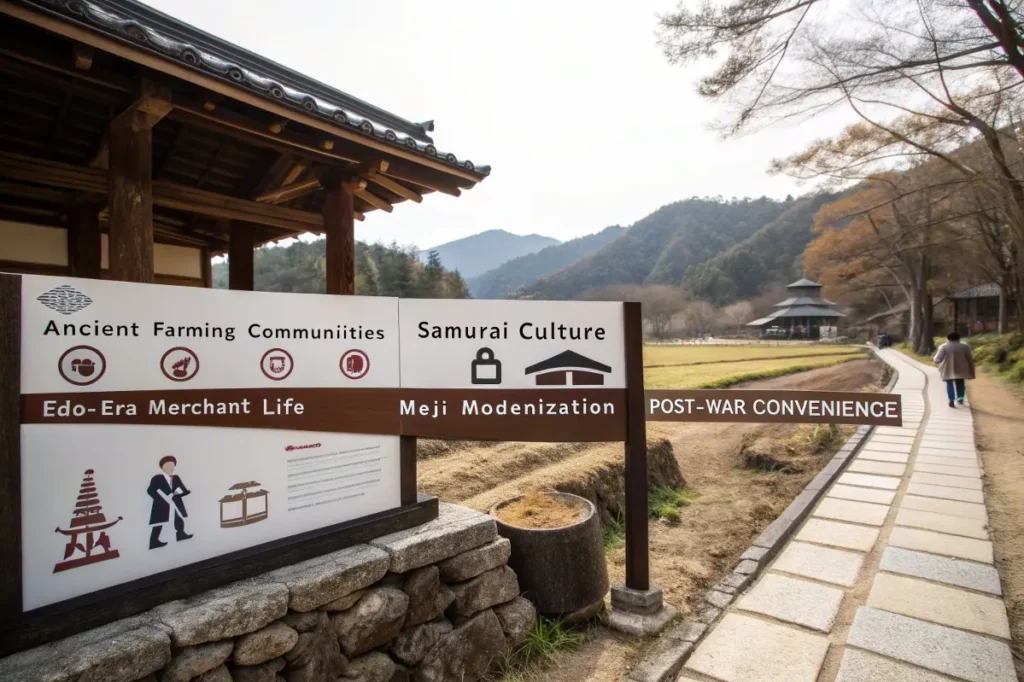
4. Practical Examples and Use Cases
- The Student on the Go
- Scenario: A high school student needs to leave by 7:00 AM.
- Breakfast: A quick bowl of leftover miso soup (warmed in the microwave), half a bowl of rice, and a small piece of leftover japanese-steak-recipe from dinner.
- Outcome: Minimal prep time, but meets the staple trifecta—carb, protein, soup—for a balanced start.
- Office Worker’s Rush Hour
- Scenario: A “salaryman” living near Tokyo must catch a train by 7:15 AM.
- Breakfast: Picks up a salmon onigiri and a carton of green tea at the konbini.
- Outcome: Quick and portable, staying close to tradition with fish and rice while accommodating a hectic commute.
- Weekend Family Spread
- Scenario: Parents are off work, kids are sleeping in.
- Breakfast: Full set: steamed rice, homemade miso soup with tofu, grilled mackerel, tamagoyaki, pickled cucumbers, and fruit slices for a sweet finish.
- Outcome: Leisurely morning fosters family bonding, letting everyone appreciate a variety of small dishes.
- Fusion Brunch for Visitors
- Scenario: You’re hosting friends who want to taste “typical Japanese breakfast” but also love Western brunch.
- Breakfast: Avocado miso toast, scrambled eggs with furikake, a small bowl of miso soup, and pickled daikon on the side.
- Outcome: A gentle, approachable introduction to Japanese flavors, bridging cultural tastes in one meal.
From conbini convenience to elaborate weekend banquets, these examples highlight the adaptability of common Japanese breakfast foods. They show that you don’t need an elaborate setup or hours to capture the essence of Japan’s morning dining tradition—just a few core elements and a willingness to embrace small dishes with complementary flavors.
5. FAQs About Common Japanese Breakfast Foods
1. What’s in a typical Japanese breakfast?
Generally, it includes steamed rice, miso soup, grilled fish, and pickled vegetables. Families might also serve tamagoyaki (rolled omelet) or tofu. The goal is balance—carbs, protein, and vegetables in one meal.
2. What are traditional Japanese breakfast side dishes?
Pickled daikon (takuan), umeboshi (pickled plum), and small servings of natto (fermented soybeans) count as iconic side dishes. Some households add leftover noodles-japanese-pan-noodles-recipe for a twist, especially if they crave a heavier meal.
3. What does a samurai eat for breakfast?
Historically, samurai diets didn’t drastically differ from commoners—rice, soup, fish, and pickles were the mainstays. Their emphasis on discipline meant meal routines rarely strayed from staple items.
4. What time do Japanese eat breakfast?
Between 6:30 and 8:00 AM on weekdays for school and work. Weekends can shift later, often turning breakfast into a leisurely brunch. If you want references for sweet morning treats, see traditional-japanese-desserts-recipe to top off your meal with a small sweet dish.
5. Do Japanese breakfasts always include fish?
Not necessarily. Eggs or tofu might replace fish in busy or vegetarian households. Some also opt for leftover authentic-japanese-barbecue-sauce-chicken-recipe-easy-delicious pieces for morning protein.
6. How can I adopt these foods in my own home?
Focus on small portions of multiple items. Cook extra rice the night before, warm miso soup in the morning, grill or microwave fish fillets quickly. Keep pickled vegetables on hand to add tang and texture.
7. Are Western influences common?
Yes. Toast, coffee, cereal, or jam might appear alongside more traditional offerings. This fusion approach is especially popular among younger generations or families that appreciate global flavors.
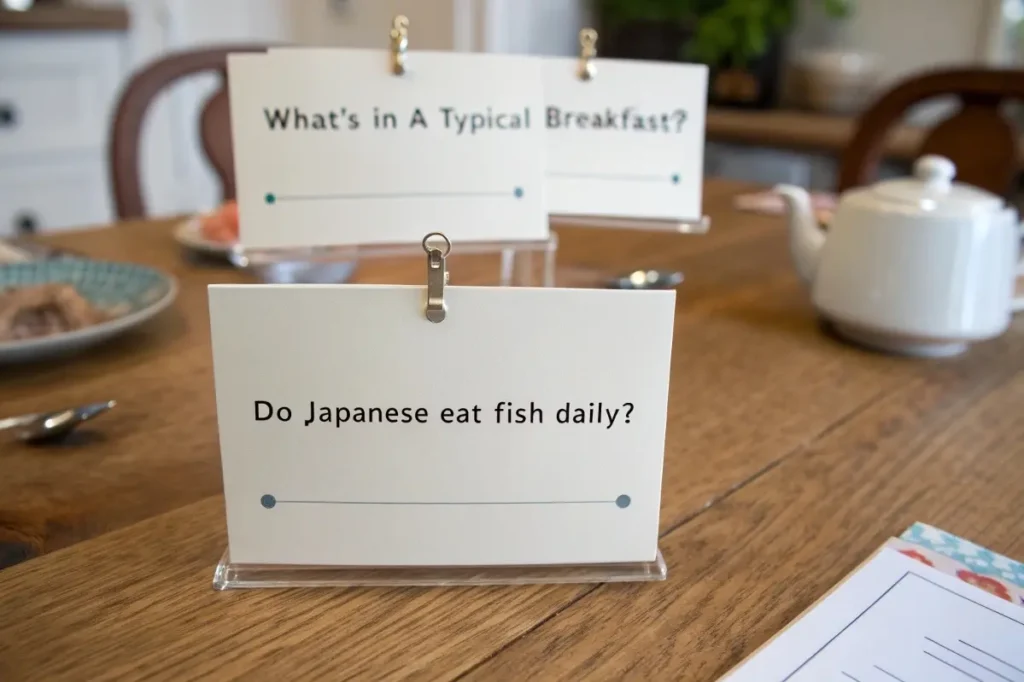
Conclusion
Common Japanese breakfast foods capture the essence of Japan’s culinary philosophy in each bite—harmony among staples, mindful portion sizes, and a balance of tastes. Whether you’re drawn to the smoky aroma of grilled fish, the tanginess of pickled daikon, or the comforting warmth of miso soup, each item coexists to create an energizing start to the day.
Even with modern time constraints, families and individuals continue to uphold these customs, modifying dishes or incorporating Western influences where necessary. A quick onigiri can replace steamed rice, while tamagoyaki can switch to scrambled eggs or leftover japanese-chicken-fried-rice-recipe-2 in a pinch. Yet the fundamental blueprint remains consistent: a synergy of flavors—savory, salty, and sometimes sweet—offered in small, complementary portions.
If you’re ready to bring these elements into your morning routine, remember that flexibility is key. Prepare rice beforehand, keep pickles and instant miso soup packets for emergencies, and experiment with side dishes to avoid repetition. This approach ensures you can adapt time-honored Japanese breakfast favorites to suit your lifestyle while preserving their cultural spirit. By doing so, you’ll discover why millions of people across Japan cherish this start to the day—and why its reputation endures worldwide.
